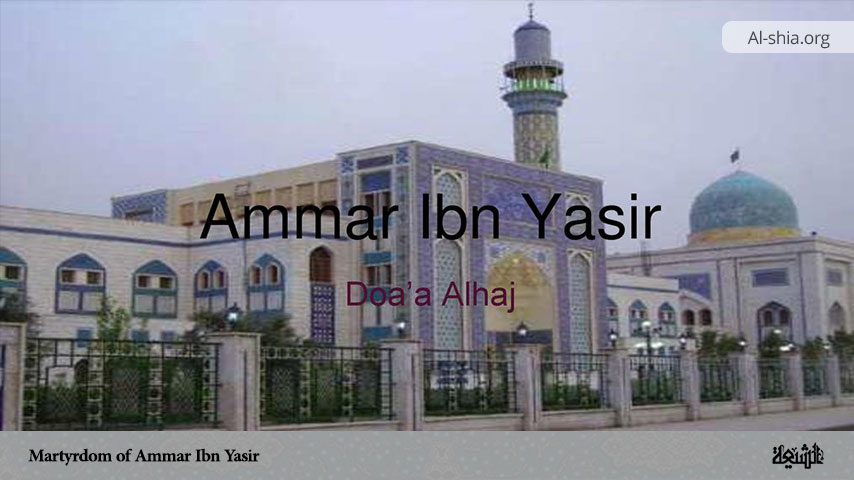It is believed by the Shiites that the office of divine leadership [Imamate] after the Prophet is a divine trust in the hand of an Imam and at the time of his death/martyrdom, it is immediately transferred to the next Imam without any interval and interruption. Based on authentic Prophetic hadiths, it is believed that there are going to be twelve Divine leaders [Imams] in succession to the Holy Prophet of God (peace be upon him and his family). That is, after the death of the Prophet (PBUHH), the world shall be ruled and governed by twelve divine leaders from the pure Prophet’s Household, the first of whom was Ali ibn Abi Ṭālib (PBUH) and the last shall be the awaited Savior, Imam al-Mahdi (AFS), who is believed to be in occultation now.
His Birth and Lineage
According to reliable historical reports, the twelfth Shia Divine Leader, Imam Muhammad al-Mahdi (PBUH) was born on 15th Sha‘bān 255 A.H. (868 CE) in Samarra, Iraq. His father is Imam Hassan ibn Ali Al-Askari, the eleventh Shia Imam. His mother is called Narjis, whose lineage goes back to Sham‘ūn, one of the disciples of Jesus Christ (PBUH). Narjis was highly respected by Hakima, the sister of Imam al-Naqi and leader of the Hashimite ladies.
The news about the anticipated birth of the awaited Savior, al-Mahdi (PBUH) who -based on Prophetic prediction-will put an end to injustice and tyranny was concealed from the public just as the birth of Prophet Moses (PBUH) was concealed from the public by divine will, at the time Pharaoh ordered the mass killing of the Israelites’ male children. Thus, in order to protect the Imam from the seducing eyes of Abbasid and its agents who were anxiously watching the family of the Prophet’s Household for the birth of this promised child, Imam Muhammad al-Mahdi was allowed to be seen only by some closed family members and a few selected companions of his father. He lived under the loving care of his father for five years.
His Imamate
According to reports, the earth cannot be empty from a divine authority; otherwise, the earth will be destroyed with its entire inhabitants. Consequently, after the death/martyrdom of an Infallible Imam, his successor who has been earlier prophesized based on a divine order and through the previous Imam, will become the succeeding Imam and the leader of the Muslim community.
It was narrated from the sixth Imam, Imam Ṣādiq (PBUH) who quoted Imam Ali (PBUH) to have said: “…Know that indeed the earth cannot be void of a Divine Authority but Allah will not, later on, let His creatures see him because of their oppression, cruelty, and committing sins. If the earth becomes void of a Divine Authority even for one moment, it collapses with all its inhabitants…”
After the martyrdom of Imam Hasan al-Askari in 260 A.H., the imamate of Imam Muhammad al-Mahdi (may Allah hasten his appearance) began. Interestingly, the imamate of Imam al-Mahdi (PBUH) began with Occultation (Ghaybat) and it has continued till the present time. Meanwhile, his imamate is divided into two parts:
1. The Minor Occultation (al-Ghaybat al-Sughra): The first 69 years of his imamate is known as the period of the Minor Occultation (al-Ghaybat al-Sughra). During this period, Imam al-Mahdi (PBUH) appointed four special representatives, one after another, as a link between himself and his Shiites. Of course, there were other representatives also but with limited jurisdiction or limited duties. The four special representatives were as follows:
I) ‘Uthmān bin Sa‘īd al-‘Amri, known as Abu Amr.
II) Muhammad bin ‘Uthmān bin Sa‘īd, known as Abu Ja‘far.
III) Husayn bin Rawh an-Nawbakhti, known as Abul Qāsim.
IV) ‘Ali bin Muhammad Samary, known as Abul Hasan.
2. The Major Occultation (al-Ghaybat al-Kubra): The period after 329 A.H. till the present is known as the Major Occultation (al-Ghaybat al-Kubra). Unlike the period of Minor Occultation (Ghaybat Sughra) where the Shiites had access to communicate with their Imam through the special deputies, there was no special deputy during the Major Occultation (Ghaybat Kubra). The Imam al-Mahdi (PBUH) will appear from the Occultation whenever Allāh allows him to do so to establish the Kingdom of God on earth, and to eradicate injustice and tyranny once and for all.
Meanwhile, during the Major Occultation, those Shiites who do not have the expertise to derive the laws from the Qur’an and the Sunna of the Infallibles should follow the guidance provided by those who are experts. A person known as Ishāq Ibn ‘Ammār asked in a letter to Imam al-Mahdi (PBUH) about the guidance during the Major Occultation. The holy Imam replied thus: “And as for the newly occurring circumstances [which have not been mentioned in the Qur’ān and Sunna], refer to those who narrate our ahādīth for they are my proof [Hujjat] upon you as I am Allāh’s Hujjat upon them.”
In accordance with some historical documents, after five years of living under the supervision of his magnanimous father; Imam Hassan al-Askarī) and precious mother; Narjis, Imam Mahdi became Imam at the age of five after the martyrdom of his father just as Prophet Jesus (PBUH) and Prophet John (PBUH) had attained the high position of prophethood in their childhood.
The first day of the Imamate of Imam Mahdi was on Friday and according to a well-known narration from Shiites’ viewpoint, the appearance of His Majesty will be on Friday as well.
According to reports, the ninth day of the month of Rabi’ al-Awwal is the anniversary of the beginning of the Divine Leadership (Imamate) of the twelfth and the Savior of our time; Imam Muhammad a-Mahdi (may Allah hasten his reappearance). In addition, it is also the day to renew the oath of allegiance to him. In light of this, the Shiites and those who wait for the appearance of this Divine Leader (Imam) used to celebrate this blessed day and consider it holy.
Of course, the Imamate of Imam Muhammad al-Mahdi (PBUH) started from the very moment of his father’s martyrdom, that is, the eighth of Rabī’ al-Awwal. However, in order to honour the day of Imam Askarī’s martyrdom by mourning him, the Shiites do not regard that very day as the beginning of the Imamate of Imam Mahdi (PBUH). Therefore, the ninth day of Rabī’ al-Awwal is considered the first day of the Imamate of Imam Mahdi and it is celebrated.
A well-known Shia scholar; Sayyid ibn Tāwūs, after registering the Imam ‘Askarī’s martyrdom on the 8th of Rabī’ al-Awwal, says, “The beginning of Imam Mahdi’s Imamate is on the 9th of Rabī’ al-Awwal. Perhaps this is the reason for celebrating this day.”
Similarly, Abū Sahl ibn Ali al-Nubakhtī, who was an authentic and reliable person for some Infallible Imams especially Imam ‘Askarī and the Imam of the Age, says: “After Mu’tamad (the cruel Abbasid caliph) had poisoned Imam ‘Askarī, I visited the Imam when his son was there. The Imam was upset and so weak that, when a container of water was given to him to drink, he could not hold it. His body was trembling and could I hear the sound of his teeth touching the container. At this moment, Imam Muhammad Mahdi arrived. By seeing him, Imam ‘Askarī became very happy, but he cried for a moment. Then Imam ‘Askarī introduced him as the last executor and deputy of the Messenger of Allah, the last Imam of the believers, and the true authority of Allah. After that, he made his will to him.”
Abū Sahl continued, “That moment I deeply sensed that it was the beginning moment of accepting the responsibility of Imamate by the Imam of the Age. Then I heard that Imam ‘Askarī said to his infallible son: “O the master of your household! Give me some water, surely I will depart to my Lord.”
Imam Mahdi gave him water and helped him to do minor ablution. Besides, Imam Hassan ‘Askarī and Imam Mahdi spoke with each other about something and I heard that Imam ‘Askarī said to his son: “Good news for you, O my son! You are the Imam of the Age, you are guided, you are the Authority of Allah on His earth, and you are my son and my executor.”
His Reappearance
After a very long Occultation, Imam al-Mahdi (PBUH) will reappear based on Allah’s command at the Holy Mosque in Mecca and his divine mission of establishing the Kingdom of God on the earth will commence. According to reports, three hundred and thirteen people will pledge allegiance to him, and then he will move towards Medina. From Medina, al-Mahdi will proceed to Kufa, Iraq. After that Prophet ‘Isa (Jesus Christ) will descend at Damascus and join Imam al-Mahdi. The headquarters of Imam al-Mahdi will be Kufa from where he will rule over the whole world. During the reign of his leadership, the blessings of Allah will be abundant; there will be no poverty; peace and security will be the rule of the day.
As earlier mentioned, even Imam al-Mahdi (PBUH) himself is waiting for Allah’s permission for his reappearance. This means that no one knows the actual time of the reappearance of Imam al-Mahdi. We have clear ahādīth stating that those who speak about the time when the Imam will make his appearance are to be declared as liars. However, it is necessary to regularly pray for his appearance and adequately prepare the ground for it.
Conclusion
Imam Muhammad al-Mahdi is the twelfth and the last Infallible Imam from the lineage of the Prophet of Islam. His divine leadership began formally soon after his father Imam Hassan Askari was martyred on 8th Rabi ul Awwal. Thus, the ninth of Rabi al-Awwal in the Islamic calendar is annually marked and celebrated world-wide by the Shia Muslims as the auspicious day of the coronation of the last infallible descendant of Prophet Muhammad (peace be upon him and household), Imam Muhammad al-Mahdi (may Allah hasten his reappearance).


















